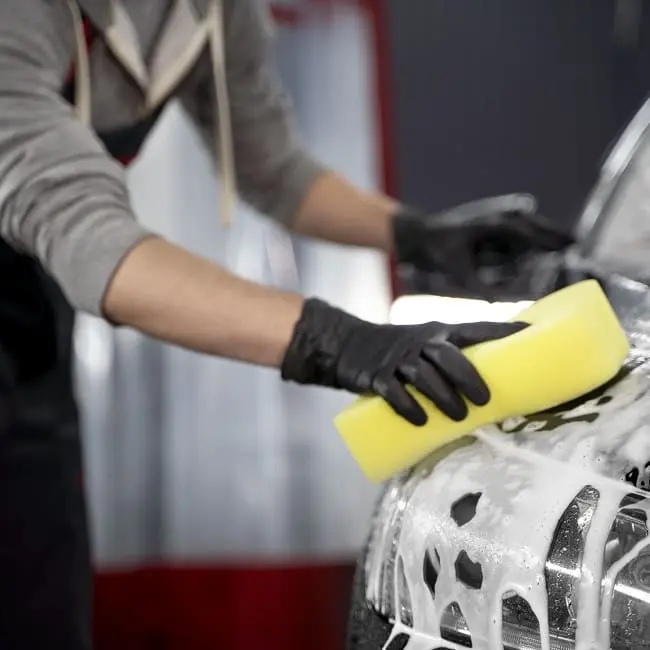Content
Your car’s bodywork determines its appearance and character. It’s also the first victim of damage caused by time, pollution, adverse weather conditions and minor accidents.
Regular cleaning is crucial to keeping your car in good condition and restoring its lustre. But what are the best ways to clean your car’s bodywork without risking damage? What products and tools should you choose?
And what steps should you take to achieve professional results? In this article, we’ll give you all the tips and tricks you need to maintain your car’s bodywork to perfection.

How to prepare your car and the necessary equipment?
Before you start cleaning your car’s bodywork, it’s essential to prepare both your vehicle and the necessary materials. Follow these three key steps for effective preparation.
Identify the type of dirt and the surface to be cleaned
The first step is to determine the type of dirt and the specific surface to be cleaned. The nature of the dirt (resin, sap, mud, dust, bird droppings or mosquitoes) determines the choice of cleaning products and techniques.
Likewise, the material of your bodywork (metal, plastic, fiberglass or carbon) requires an adapted approach.
For example, removing resin may require pouring boiling water over the stains, while cleaning plastic requires less hot water to avoid deformation.
Choosing the right products for bodywork cleaning
The second step is to choose products specifically formulated for bodywork cleaning, which are both effective and gentle on the material. Depending on the desired effect (cleaning, shine, protection, renovation or waxing), there are a variety of products to choose from: cleaners, polishes, renovators, waxes and more.
For example, a shine shampoo is ideal for cleaning and shining regularly-maintained bodywork, while a polish offers extra protection against aggression, and a renovator breathes new life into tarnished paintwork. It’s vital to follow each product’s instructions carefully, respecting recommended dosages and application times.
Essential tools: sponge, microfiber and bucket
The third step is to assemble the essential tools for effective bodywork cleaning. At the very least, you’ll need a bucket, a sponge, a microfiber cloth, a wash glove, a squeegee and absorbent wipes. It’s important to avoid the use of abrasive brushes or cloths, which could scratch the paint.
For rinsing, a high-pressure cleaner or a simple jet of water will suffice. For stubborn stains, the use of a spray gun, aerosol or touch-up pen may prove useful.
Detailed steps for effective bodywork cleaning
Once your car and the necessary materials are ready, you can start cleaning the bodywork. Follow these four steps for flawless results.
Initial rinse to remove surface residues
Start by rinsing the bodywork with hot water to remove surface residues such as dust, sand, insects or bird droppings. Use a water jet, a high-pressure washer or opt for a car wash.
Avoid automatic rollers, which can damage paintwork. Rinse from top to bottom, from the roof down to the wheels, not forgetting less visible areas such as wheel arches, rocker panels and mirrors.
Application of bodywork-specific shampoo
Next, apply a specific body shampoo using a sponge, wash mitt or soft brush. Choose a product suited to the paint and condition of your bodywork, from options such as shine shampoos, polishes, renovators or waxes.
Follow the directions for use, dosage and application time carefully. Wash the bodywork in small sections, using circular movements to avoid scratching. Don’t forget to clean windows, headlights, lights and license plates.
Hand-washing techniques to preserve paintwork
For the third step, opt for manual washing techniques to protect the paintwork and avoid marks. Use two buckets: one for the soap mixture and the other for clear water, to rinse your cleaning tool.
Change the water frequently to avoid spreading dirt on the bodywork. Opt for sponges or microfiber cloths, which are softer and more absorbent than conventional versions, and avoid abrasive materials that could scratch the paintwork.
Rinse and dry for a perfect finish
Finally, rinse and dry the bodywork for a flawless finish. Use clear water to remove any shampoo or polish residue. Avoid leaving the bodywork to dry in the sun, as this may leave streaks or alter the effectiveness of the products.
Dry the bodywork with a chamois, terry towel or microfiber cloth, working in small areas from top to bottom. Be sure to dry windows, headlights, lights and license plates too.

Maintain cleanliness and protect the bodywork over the long term
To keep your car spotless and protect its bodywork for the long term, follow these three essential tips.
Use protective products: wax and polish
Start by applying protective products such as wax or polish. These solutions create a protective barrier over the paint, increasing its resistance to scratches, stains, UV effects and weathering.
These products also add a remarkable shine and smoothness to the bodywork. Be sure to apply them to a clean, dry body, following the instructions for use and recommended drying times.
It’s important to renew this protection regularly, every three months or so.
Tips for preventing scratches and oxidation
Next, it’s crucial to prevent scratches and oxidation. Avoid any contact between the bodywork and abrasive materials or substances, such as keys, jewelry, brushes or chemicals. It’s also advisable not to park under trees to avoid damage caused by sap, leaves or falling fruit.
You should also avoid extreme temperature variations, which can cause cracks or blisters in the paintwork. In the event of scratches or damage, a quick repair is recommended, using a touch-up pen, putty or protective film.
Recommended cleaning frequency for bodywork in good condition
Finally, regular cleaning of your bodywork is essential. Although there is no universal frequency, it is generally advisable to clean the bodywork at least once a month. This frequency can be increased if your vehicle is particularly exposed to dirt or the elements.
You should also adapt your cleaning routine according to the season: in winter, rinse more frequently to remove road salt, while in summer, avoid cleaning directly under the sun to prevent streaking or heat damage.
Now you know all the secrets of how to wash your car’s body like an expert. You’ll learn how to prepare your vehicle, which tools are essential, how to clean the body thoroughly and how to keep it clean and protected over the long term.
By regularly maintaining your car’s bodywork, you’ll ensure it lasts longer, its resale value is optimized, and it looks as good as new.
- Discover also
- What does 4×4 mean?
